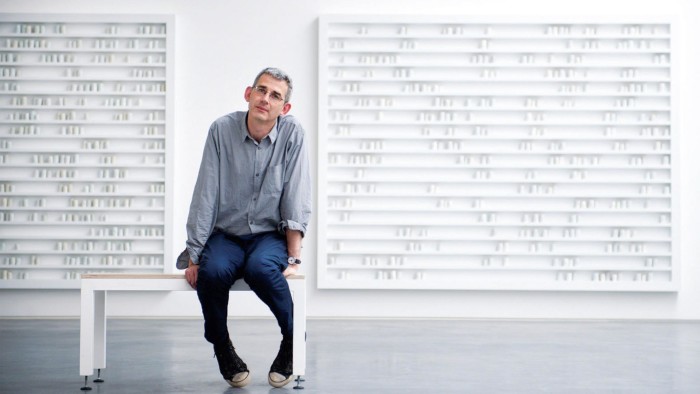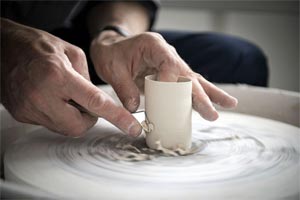Edmund de Waal on his Gagosian show, ‘Atemwende’

Simply sign up to the Life & Arts myFT Digest -- delivered directly to your inbox.
You may know Edmund de Waal as the author of The Hare with Amber Eyes, which follows dozens of thumb-sized sculptures on their adventures around the globe. These netsuke – miniature figures carved in ivory, boxwood or boar’s tusk – collide with history, pass from generation to generation of a single family, and survive events that millions of people did not. Created in Japan, they drift to Paris, Vienna and back to Tokyo, before settling, for now, in de Waal’s south London home. Their wanderings are almost certainly not complete.
Apart from being a bestselling writer, however, de Waal’s day job is as a ceramicist whose refined creations nestle in such distinguished venues as Tate Britain and the Victoria and Albert Museum. The Gagosian Gallery, betting that literary eminence will boost his artistic renown in the US, has brought de Waal’s paper-thin sculptures to Madison Avenue, disposing them in fragile squadrons.
Atemwende, de Waal’s first commercial show in the US, is a black-and-white, whispering affair, very fine and very distant. There’s a kinship between the tersely lyrical style of his prose and the controlled emotion that seeps into three dimensions. In The Hare With Amber Eyes, the story keeps threatening to overwhelm the author, who keeps sentimentality in check with dogged self-restraint. The result is a narrative of laconic sorrow. The sculpture, too, is aloof, cool and disciplined. But, even at a remove, we can feel that same repressed quiver. All the works are for sale.
The basic element of his work is the diminutive, intricate vessel, fashioned out of a thin porcelain membrane. Longer ones stretch into tubes; squatter ones look like cups. On occasions a plate intrudes. This tableware mimics and mocks functionality; a mere clink of a teaspoon would shatter it.
At Gagosian, the art is inseparable from its installation. De Waal designed the aluminium, Plexiglas and wood cabinets himself: some lie tantalisingly open, daring viewers to reach out and grab the jewel-like little pots; others are huge and hazed by a cloudy pane, so the contents drift into the mist. The arrangement is suggestive, rather than explanatory. Each item is a single rune, clustered into abstract words, spaced at rhythmic intervals and organised into stanzas. The whole ensemble scans like a multipart epic in verse.
De Waal has such strong feelings about these various forms of presentation that the context can upstage the objects. In Hare, he ruminates at length upon his experience of the vitrine in his uncle’s Tokyo home. Sliding open the doors was integral to the ritual of viewing the netsuke – a way to pierce the museum-like membrane.

“The vitrines exist so that you can see objects, but not touch them: they frame things, suspend them, tantalise through distance,” he wrote. This was a realisation he came to gradually and grudgingly. “I spent the first 20 years of my life as a potter earnestly trying to get objects out of the glass cases in which my pots were often placed in galleries and museums. They die, I’d say, behind glass, held in that airlock. Vitrines were a sort of coffin: things need to be out and to take their chances away from the protection of formal display, to be liberated. ‘Out of the drawing room and into the kitchen!’ was a sort of manifesto.”
De Waal eventually came to understand that a vitrine is meant to be opened – that the gentle creak of the door or the pulling aside of the curtain are dance steps in the choreography of seduction. This sensual prelude leads to a series of progressively more intimate acts: gazing, selecting, reaching in, picking up – and finally what he likes to call “the electric encounter between a hand and an object”.
Of course, handling such objects is the privilege of ownership, so visitors at Gagosian can only fantasise about that quasi-erotic meeting of flesh and clay. We are the touchless gawpers, marvelling from afar at the cosmic crescendo of possession. And de Waal doesn’t even make voyeurism easy, since he occludes as much as he reveals. In “Your hand full of hours”, a translucent scrim divides the foreground from the rear, like a stage curtain. In the front, a row of cylinders stands at attention, crisp and detailed behind clear glass. In the back, a similar set offers a dim and blurry impression, as if they were only projected images, flickering on the walls of a cave. So much for “out of the drawing room and into the kitchen”. It’s more like “out of the drawing room and into the fog”.
De Waal’s Gagosian show brims with so much ambivalence that it proves frustratingly oblique. He has said his work deals with the drama of owning and collecting art – it’s about having and losing, and about all the ways objects are kept together, stolen or dispersed. Yet the monochrome repetitiveness of the display seems to matter more than any individual object. Removing one, or even several, would do no more damage to the show’s integrity than cutting a measure or two from an opera by Philip Glass.
This airy, ungraspable minimalism seems so at odds with the book’s sharp tactile yearnings, and the individual specificity of the pieces he describes. In Hare, he marvels at the indestructibility of his family’s collection – at how a little carving could survive the caress of countless hands, slide compactly into a pocket, and traverse oceans. As a writer, De Waal made those hardy, quirky art works come to life through their tactile connections with humans. As an artist, he does the opposite, churning out platoons of exquisitely generic ghosts.
‘Atemwende’, Gagosian, New York, to October 19, gagosian.com
Comments